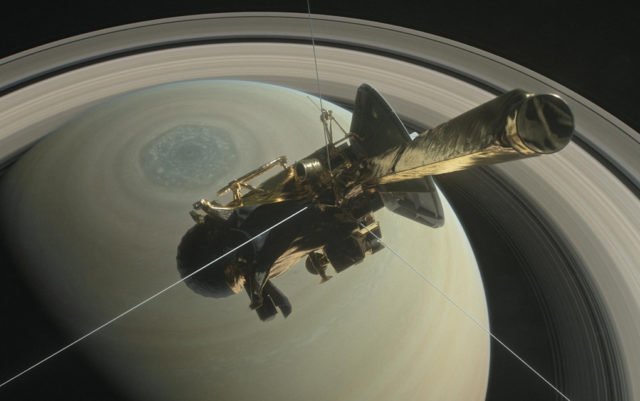
I finally arrive on the Caltech campus in Pasadena, California, around 3:30 a.m. on Friday, Sept. 15 to bear witness to the final gravitational dance between the Cassini spacecraft and the so-called “Jewel of the Solar System,” the planet Saturn. Hundreds of scientists and engineers whose careers have intersected with Cassini over the years have come from all over the world to pay their last respects to a mission that has touched their lives and brought so many people together. In a very real sense, this is a large multi-generational family who has worked together for decades. They laugh and cry together and share in the beautiful legacy they have built.
Live coverage from mission control at NASA’s Jet Propulsion Laboratory (JPL) begins at 4 a.m., projected onto three gigantic screens on the Beckman Mall lawn at Caltech. For nearly the next hour, the crowd watches for the inevitable loss of signal. But let’s pause the clock for one moment to talk about why we are here.
The Cassini mission was a NASA flagship mission that orbited Saturn and its wonderful moons and rings for more than 13 years. Launched Oct. 15, 1997, the spacecraft arrived at its destination on June 30, 2004 and began sending us a constant stream of revolutionary discoveries, which changed our understanding of the Saturn system, as well as the solar system as a whole. Cassini was able to interrogate Saturn, its moons and rings with a host of sophisticated scientific instruments, allowing for unprecedented discoveries.
Dr. Larry Esposito of the Laboratory for Atmospheric and Space Physics (LASP) at the University of Colorado and principle investigator for the Ultraviolet Imaging Spectrograph (UVIS) on-board Cassini has been with the project since its inception, nearly 30 years ago. “I am proud of the Cassini mission accomplishments, but sad to see it end,” says Esposito who has led the team of scientists and students who work with UVIS data. Esposito adds, “The UVIS team has had great accomplishments” and “produced many [scientific] papers and trained many students.”
The UVIS instrument has allowed for spectroscopic analysis of Saturn, its moons and rings. An imaging spectrograph examines light (in this case ultraviolet light) in many different wavelengths. You can think of these wavelengths as different colors of light. Unlike your digital camera, which reads red, green and blue light, a spectrograph can examine hundreds or even thousands of colors at once. These data are collectively called a spectrum and can provide clues about the composition of the material that the instrument is investigating. Think of the spectrum as a fingerprint. Each material has its own spectral fingerprint. Utilizing these data, scientists can determine the composition of the rings, moons and the atmospheres of Saturn and Titan.

Perhaps the most stunning finding of the mission was the discovery of water ice jets on the south pole of the little moon Enceladus, which revealed for the first time a liquid water ocean hidden beneath its icy crust. This unexpected wonder taught us that oceans, and the existence of conditions favorable to life, were much more common than we previously believed. An evaluation of the potential for life on Enceladus will have to be left to future missions, but Cassini has pointed the way. UVIS played a key roll in identifying the composition of those plumes of water.
According to Dr. Amanda Hendrix at the Planetary Science Institute, who has been a part of the UVIS team since 1999 and has served as a co-investigator, “The contributions of UVIS to the plume discovery at Enceladus, and to its continued study, have been particularly important.” Her primary role has been to investigate the surface composition of Saturn’s icy satellites, such as Phoebe, Enceladus and others.
In the final moments of the mission, the crowd at Caltech becomes very quiet. The end is inevitable, but the human psyche strains against such suspense. Two minutes and counting until expected loss of radio signal. The live feed from mission control at JPL gives the audience a view of the live telemetry, the radio signal from the spacecraft. At 4:55, we are informed that the altitude of the spacecraft is only 1,000 miles above the planet. Forty-six seconds later the display in front of us shows the signal fade to zero. A silence comes over the crowd until we hear the official word from Program Manager Earl Maize, “The signal from the spacecraft is gone, and within the next 45 seconds, so will be the spacecraft.”
And then something wonderful happens: applause. Tears are certainly welling up in many peoples eyes, including my own, but the overwhelming feeling I get from those around me is one of camaraderie and bitter-sweet happiness. People are hugging, crying and smiling. Many hundreds of people from 27 different nations participated in this epic journey. And none of them will ever forget it.
As Dr. Hendrix puts it, “It was very moving. What an outstandingly wonderful mission Cassini has been. … It’s sad to have the spacecraft now gone, but it’s been an awesome mission. And there’s still so much data to analyze!”
The body of scientific knowledge gained, with nearly 4,000 scientific papers published to date, will be Cassini’s legacy and will inspire future generations of scientists for decades to come.
Josh Elliott is a scientific programmer and professional research assistant at the Laboratory for Atmospheric and Space Physics, CU Boulder














